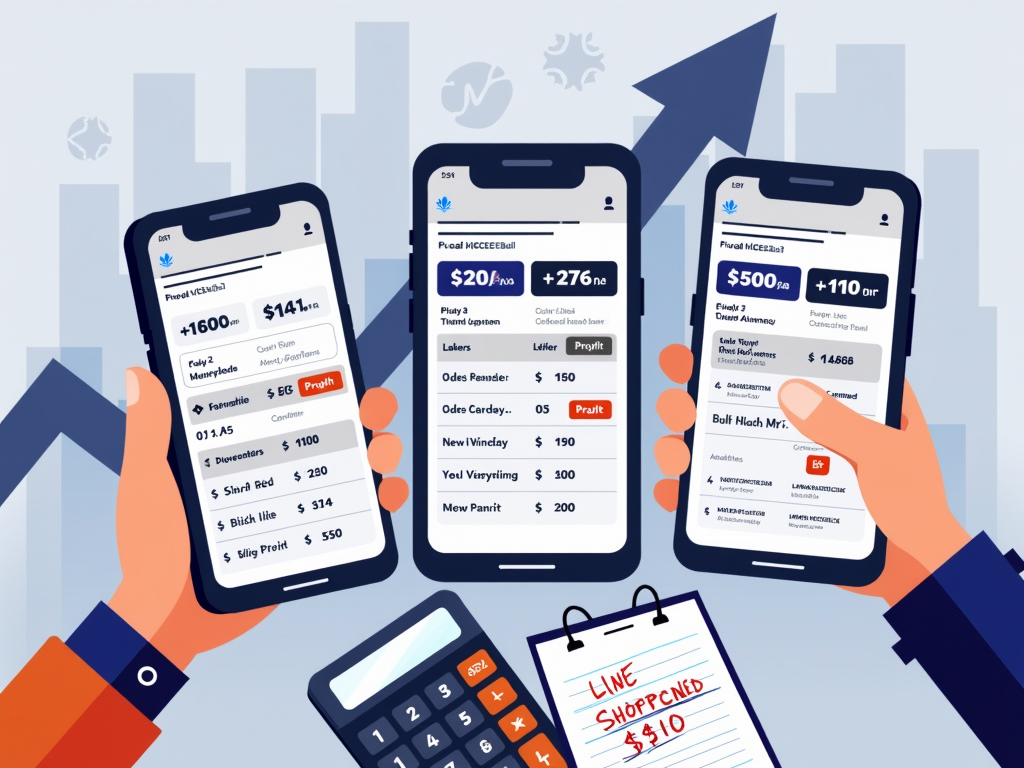Keys to Sports Betting Success
Sports betting success demands smart choices and disciplined strategies. My research reveals that preventable mistakes cause the majority of betting losses, particularly poor bankroll management and emotional decision-making.
Key Takeaways
- Thorough research and statistical analysis are essential before placing any bets – gut feelings lead to losses.
- Never chase losses – stick to consistent bet sizing of 1–3% of your total bankroll per wager.
- Compare odds across multiple sportsbooks to maximize potential returns on every bet.
- Keep emotions out of betting decisions, especially when wagering on favorite teams.
- Avoid complex parlay bets which have much higher house edges than straight single-game wagers.
Discipline and Data: The Betting Edge
My analysis shows that successful sports betting requires strict discipline and a data-driven approach. I prioritize statistical insights over hunches or emotional reactions. A systematic method helps control risk and protect bankroll longevity.
The Importance of Line Shopping
Line shopping plays a key role in my betting strategy. I check multiple sportsbooks to find the best available odds for each wager. Even small differences in odds add up significantly over time.
Why Chasing Losses is Dangerous
Personal experience has taught me to avoid chasing losses – one of the fastest ways to deplete a bankroll. I maintain consistent bet sizing between 1–3% regardless of recent results.
Stick to Single-Game Wagers
Simple, straight bets form the foundation of profitable betting. Parlays seem attractive but carry much steeper house edges. I focus primarily on single-game wagers where I can apply deep statistical analysis.
Why Betting Without Research Could Cost You Everything
I’ve learned that success in sports betting stems directly from solid research and preparation. Understanding betting fundamentals requires dedicated research – this isn’t optional, it’s essential.
Research Components That Shape Smart Betting
Before placing any wagers, I make sure to analyze multiple data points that can impact game outcomes. Here are the critical elements I recommend examining:
- Recent Performance Metrics: Review team performance from the last 5-10 games to spot trends and patterns
- Statistical Analysis: Compare offensive and defensive stats between teams
- Injury Reports: Check which key players are out or playing through injuries
- Historical Matchups: Look at how teams have performed against each other previously
- Travel Schedule: Consider fatigue factors like back-to-back games or long road trips
- Weather Conditions: For outdoor sports, weather can significantly impact performance
According to ESPN Stats & Info, successful bettors typically spend several hours researching a single game. Let me put this into perspective – if you’d bet on the favored Team A without checking that their All-Star point guard was injured and they’re playing their third away game in five days, you’d miss crucial factors affecting their performance.
Smart wagering decisions come from comprehensive analysis, not gut feelings. I rely on respected platforms like Stathead for detailed statistics and team news reports for the latest updates. These resources provide the foundation for making informed betting choices rather than gambling blindly.
The difference between casual and professional bettors often lies in their approach to research. While casual bettors might glance at win-loss records, professionals dig deeper into advanced metrics, team dynamics, and situational factors. Understanding different bet types isn’t enough – you need to know why you’re placing each bet based on solid data.
Remember, sports betting isn’t about picking winners – it’s about finding value based on thorough research. Each piece of information you gather helps create a clearer picture of potential outcomes and betting opportunities. Missing even one crucial detail could mean the difference between a winning and losing bet.
The Hidden Danger of Chasing Losses in Sports Betting
Understanding Loss Aversion Psychology
Let’s face it – losing money stings much harder than winning feels good. The psychology of loss aversion runs deep in sports betting, where I’ve seen countless bettors spiral into dangerous territory trying to recover their losses. This powerful emotional response can quickly override logical thinking and bankroll management strategies I teach in my sports betting fundamentals guide.
Picture this common scenario: You place a $50 bet on what seems like a sure thing, but it doesn’t pan out. That loss creates an urgent need to get that money back, leading to a $100 bet to recover the original $50. When that bet also fails, panic sets in, pushing you to wager $200 in a desperate attempt to break even. Before you know it, a manageable $50 loss has ballooned into a $350 disaster.
Breaking the Chase Cycle
The pressure to recover losses can seriously impact your decision-making abilities. I’ve learned that stress and urgency often lead to:
- Placing bets on unfamiliar sports or teams
- Ignoring crucial research and analysis
- Making larger wagers than your bankroll can handle
- Betting on risky prop bets with poor odds
The key to successful sports betting lies in treating each wager as an independent event. Your previous losses shouldn’t influence your next bet’s size or selection. I always recommend stepping back when emotions start driving your decisions – sometimes taking a short break can prevent major financial setbacks.
Instead of chasing losses, focus on maintaining consistent bet sizing and sticking to sports you understand well. This approach might feel less exciting, but it’s proven more effective for long-term success in wagering wisely. Remember, professional sports bettors stay successful by making calculated decisions, not emotional ones.
Smart bankroll management means accepting that losses are part of the game. By keeping your bets consistent and within your means, you’ll protect yourself from the devastating effects of chase betting. I suggest setting strict daily and weekly limits – and most importantly, sticking to them regardless of outcomes.

Smart Money Management: The 1-3% Rule That Saves Bankrolls
Setting Your Standard Betting Units
I’ve learned that proper bankroll management can make or break your sports betting success. The most effective approach is sticking to a strict 1-3% rule for each wager. This means if I start with a $1,000 bankroll, my standard bets should range between $10 to $30 per play. For those special occasions when I’m extra confident in a specific prop bet, I might push it to 5% – but that’s my absolute ceiling.
Flat Betting vs. Percentage-Based Systems
The beauty of percentage-based betting shines through in its built-in protection against losing streaks. Let’s break down why this approach works better than placing the same flat amount regardless of your bankroll size. Here are the key differences:
- With a percentage-based system (2% per bet on a $1,000 bankroll):
- First loss: Bankroll drops to $980, next bet is $19.60
- Second loss: Bankroll drops to $960.40, next bet is $19.21
- Third loss: Bankroll drops to $941.19, next bet is $18.82
- Fourth loss: Bankroll drops to $922.37, next bet is $18.45
- Fifth loss: Bankroll drops to $903.92, keeping 90% of initial bankroll
- With aggressive flat betting (20% or $200 fixed bets):
- First loss: Bankroll drops to $800
- Second loss: Bankroll drops to $600
- Third loss: Bankroll drops to $400
- Fourth loss: Bankroll drops to $200
- Fifth loss: Complete wipeout
This conservative approach might seem slow, but it’s proven effective for beginners learning sports betting and seasoned bettors alike. I’ve found that smaller, consistent bets create staying power in the betting market, letting me weather the inevitable cold streaks while keeping enough capital to bounce back.
The percentage system automatically adjusts my bet sizes based on my current bankroll – reducing my exposure during losing streaks and increasing my potential profits during winning runs. This built-in flexibility helps maintain discipline and prevents emotional decisions that often lead to chasing losses with larger bets.
For new bettors placing their first moneyline or spread wagers, I recommend starting at the conservative 1% mark. As you gain experience and develop a proven track record, gradually increase your standard unit size toward 2-3%. This measured approach helps build confidence while protecting your bankroll during the learning phase.
Missing Out on Better Odds? Here’s What It’s Costing You
The Real Impact of Line Shopping
Let’s break down a clear example that shows why comparing odds across sportsbooks is crucial for your betting success. Picture placing a $100 bet on the Lakers at +100 odds at one sportsbook. If they win, you’ll pocket $100 in profit. But what if I told you another sportsbook has the Lakers at +110? That same winning bet would net you $110 — a straightforward 10% boost in profits just by taking a few minutes to check different sites.
Small differences in odds can make a massive difference to your bottom line. Take these common scenarios I’ve spotted across major sportsbooks:
- Standard NFL spread bets might be -110 at DraftKings but -105 at PointsBet
- MLB money lines can vary by 15-20 points between BetMGM and FanDuel
- Player props often show 5-10 point differences between Caesars and BetRivers
These variations might seem minor, but they add up fast. If you’re betting -110 instead of -105 consistently, you’ll need to win 52.4% of your bets to break even versus 51.2% at the better odds. That 1.2% difference could easily flip a profitable betting year into a losing one.
Understanding standard betting odds is just the start — I’ve learned that success in sports betting requires attention to the finer details. Before placing any bet, I always check at least three different sportsbooks. This simple habit has boosted my potential returns by 5–15% on average.
For newer bettors focusing on basic betting fundamentals, line shopping might seem like an extra hassle. But trust me — it’s worth every second. Think of it this way: if you’re making $1,000 worth of bets per month, even a 5% improvement in odds could mean an extra $600 in annual profits.

Keep Emotions Out of Your Betting Strategy
Understanding Emotional Triggers
Betting on sports demands a clear head and rational thinking, yet emotional attachments can cloud judgment in significant ways. I’ve noticed that many bettors struggle to separate their fan loyalties from their betting decisions, particularly when dealing with favorite teams or heated rivalries. This attachment often leads to overvaluing certain teams based on personal preference rather than statistical merit.
The heightened emotions during rivalry games create another layer of complexity for sports betting fundamentals. These matchups can trigger impulsive bets driven by team loyalty rather than careful analysis of the actual odds and matchups.
Managing the ‘Tilt’ Factor
The poker concept of ’tilt’ perfectly mirrors what happens in sports betting when emotions take control. After experiencing losses, many bettors make increasingly risky wagers in an attempt to recover quickly. This emotional spiral can lead to:
- Increasing bet sizes beyond planned limits
- Placing multiple bets simultaneously without proper research
- Chasing losses with high-risk proposition bets
- Ignoring established bankroll management rules
- Making snap decisions without analyzing the odds
To maintain discipline, I recommend creating a clear betting strategy before placing any wagers. This strategy should include specific rules about bet sizes, which types of bets to make, and exact criteria for selecting games. By referring back to these predetermined guidelines, you’ll find it easier to resist emotional impulses that could derail your betting success.
Setting strict deposit limits and taking regular breaks after losses also helps maintain emotional control. Remember, successful sports betting requires treating each wager as a business decision rather than an emotional investment in your favorite team’s success.
The Truth About Complex Bets and Their Hidden Costs
Understanding the Real Cost of Parlay Betting
I’ve found that complex bets like parlays can be incredibly appealing at first glance. The potential for massive payouts often draws in new bettors, but there’s a catch that many don’t spot right away – the actual odds aren’t as favorable as they appear.
Let’s break down what’s really happening with these attractive-looking bets. A parlay that should pay out at +700 odds might only offer +600, meaning you’re leaving significant value on the table. This reduced payout is just the tip of the iceberg when it comes to the true cost of placing complex bets.
The house edge on complex bets can be staggering. Here’s what you need to consider before placing these types of wagers:
- Parlay bets carry a house edge between 10-30%, much higher than single-game bets
- Teaser bets often have even worse true odds than their advertised payouts suggest
- Each additional leg in a parlay increases the house’s advantage
- The actual probability of winning decreases more than the odds compensate for
I recommend sticking to straightforward moneyline and spread bets while you’re learning the ropes. These simpler wagers give you a much better chance of understanding how odds work and how to spot real value.
There’s a reason sportsbooks heavily promote parlays and other complex bets – they’re incredibly profitable for the house. The flashy marketing and promise of big wins mask the mathematical reality that these bets are rarely worth the risk. Instead of chasing the allure of a massive parlay payout, I suggest focusing on mastering betting fundamentals through single-game wagers.
The math behind complex bets can be deceptive. While a traditional spread bet might carry a house edge of 4.76%, adding just one more game to create a parlay can double or triple that edge. This means you’re giving up a significant portion of your potential winnings before you even place the bet.
If you’re interested in maximizing your chances of success, consider exploring prop bets as an alternative to parlays. Props can offer unique opportunities while maintaining more reasonable house edges compared to complex multi-leg wagers.
Remember that successful sports betting isn’t about hitting home runs with every bet. It’s about making smart, calculated decisions that give you the best chance of long-term success. By staying away from complex bets with hidden costs, you’ll be better positioned to build a sustainable betting strategy.
Sources:
ESPN Chalk
Action Network
VSiN (Vegas Stats & Information Network)
Covers





